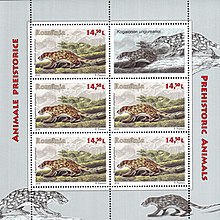| This article includes a list of references, related reading, or external links, but its sources remain unclear because it lacks inline citations. Please help improve this article by introducing more precise citations. (May 2021) (Learn how and when to remove this message) |
| Kogaionon ungureanui Temporal range: Late Cretaceous | |
|---|---|

| |
| Scientific classification | |
| Domain: | Eukaryota |
| Kingdom: | Animalia |
| Phylum: | Chordata |
| Class: | Mammalia |
| Order: | †Multituberculata |
| Family: | †Kogaionidae |
| Genus: | †Kogaionon Rădulescu R. & Samson P., 1996 |
| Species: | †K. ungureanui |
| Binomial name | |
| †Kogaionon ungureanui Rădulescu R. & Samson P., 1996 | |
Kogaionon is a mammal genus from the Upper Cretaceous of Romania. It lived in Transylvania the same time as some of the last non-avian dinosaurs and was a member of the extinct order of Multituberculata. It was named after Kogaionon, the holy mountain of the ancient Dacians. It lies within the suborder Cimolodonta and the family Kogaionidae. The genus Kogaionon was named by Rădulescu R. and Samson P. in 1996.
This genus is known from one species, Kogaionon ungureanui, the fossil remains of which have been found in the Maastrichtian (Upper Cretaceous) Sinpetru Beds of the Hateg Formation in Romania. It is a micro-mammal, based on a well-preserved and near complete skull. The species name is in appreciation of the geologist Costin Ungureanu, who found the fossil.
References
- Rădulescu & Samson (1996), "The first multituberculate skull from the Late Cretaceous (Maastrichtian) of Europe (Haţeg Basin, Romania)". Anuarul Institutului de Geologie al României, Supplement 1, 69, p. 177-178.
- Kielan-Jaworowska Z & Hurum JH (2001), "Phylogeny and Systematics of multituberculate mammals". Paleontology 44, p. 389-429.
- Much of this information has been derived from MESOZOIC MAMMALS; "basal" Cimolodonta, Cimolomyidae, Boffiidae and Kogaionidae, an Internet directory.
| Taxon identifiers | |
|---|---|
| Kogaionon ungureanui | |
| Kogaionon | |
This article about a Cretaceous mammal is a stub. You can help Misplaced Pages by expanding it. |

